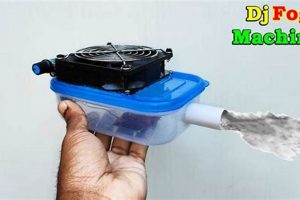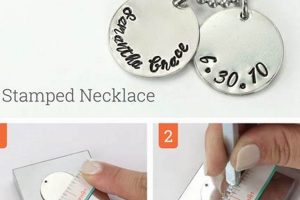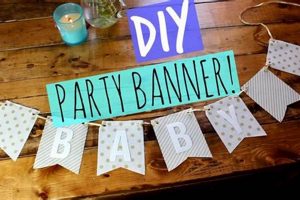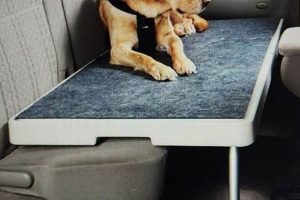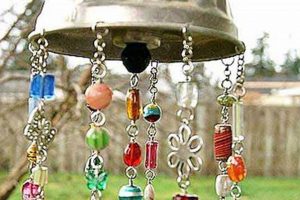The construction of customized feline waste disposal systems offers an alternative to commercially manufactured products. These homemade solutions are often tailored to specific spatial requirements, material preferences, and aesthetic considerations. For example, a repurposed plastic storage container, modified with a suitable entry point, can serve as a functional and cost-effective alternative to standard litter boxes.
The value of creating personalized cat sanitation facilities lies in the potential for cost savings and increased owner satisfaction. By utilizing readily available materials, expenses associated with pre-made products can be significantly reduced. Furthermore, individuals can address unique pet needs, such as orthopedic limitations requiring shallow entries, or behavioral preferences demanding enclosed environments. Historically, resourceful pet owners have adapted various containers for this purpose, reflecting a practical approach to animal care.
The following sections will detail specific construction techniques, material selections, and design considerations relevant to building efficient and aesthetically pleasing solutions for managing feline waste. This guide aims to provide a framework for creating a practical and personalized pet care item.
Construction Pointers
The subsequent guidance provides practical advice for the successful development of a functional and enduring feline waste management receptacle. Adherence to these principles will enhance both the utility and longevity of the finished product.
Tip 1: Material Selection: Choose non-porous materials such as durable plastics, which resist odor absorption and facilitate ease of cleaning. Avoid absorbent materials like unfinished wood that can harbor bacteria.
Tip 2: Size Considerations: Determine appropriate dimensions based on the cat’s size, ensuring sufficient space for comfortable turning and digging. A general rule is a length at least 1.5 times the cat’s body length.
Tip 3: Entry Point Design: Consider the cat’s age and mobility when designing the entry. Senior cats or those with arthritis may require a low-profile entrance to minimize joint stress.
Tip 4: Ventilation: If constructing an enclosed receptacle, ensure adequate ventilation to prevent ammonia buildup and promote air circulation. Ventilation holes or a partially open top are recommended.
Tip 5: Liner Compatibility: Consider the use of disposable liners to simplify cleaning and reduce direct contact with waste. Ensure the chosen liner is compatible with the receptacle’s dimensions.
Tip 6: Stability: Ensure the completed structure is stable and resistant to tipping, particularly if the cat tends to dig vigorously. A wide base or weighted bottom can improve stability.
Tip 7: Smooth Edges: Eliminate any sharp edges or protrusions that could potentially injure the cat during use. Sanding or covering edges with protective material is advisable.
Effective execution of these recommendations will contribute to the creation of a hygienic and user-friendly solution for feline waste management. This approach promotes both pet well-being and owner convenience.
The subsequent section will address common design challenges and provide troubleshooting strategies for addressing potential issues encountered during the construction process.
1. Material Safety
The integrity of a domestic cat’s health relies significantly on the materials used in self-constructed waste receptacles. Improper selections can lead to adverse health outcomes due to direct exposure and potential ingestion of toxic substances. The construction of a “diy kitty litter box” without careful consideration of material composition constitutes a direct threat to the animal’s well-being.
For instance, utilizing plastics that leach Bisphenol A (BPA) presents a risk of endocrine disruption in cats. Similarly, absorbent materials treated with chemical preservatives, if ingested, can cause gastrointestinal distress or more severe systemic toxicity. Therefore, the choice of inert, non-toxic materials, such as food-grade plastics or untreated ceramics, is paramount. Real-world examples demonstrate that neglecting this precaution can result in chronic illness, necessitating veterinary intervention and incurring significant financial burdens. The practical significance of understanding material properties is undeniable; it directly translates to preventative healthcare for the pet.
In conclusion, ensuring material safety is not merely a design consideration but a critical component of responsible pet ownership when undertaking “diy kitty litter box” construction. Overlooking this element introduces avoidable health risks, emphasizing the need for thorough research and informed material selection. The challenge lies in balancing cost-effectiveness with the imperative of providing a safe and sanitary environment for the animal. This diligence contributes significantly to the overall health and longevity of the feline companion.
2. Optimal Size
The dimensional characteristics of a homemade feline waste receptacle directly influence its usability and hygiene. Insufficient dimensions may deter the cat from utilizing the facility, leading to inappropriate elimination behaviors. Conversely, excessive dimensions might present spatial inefficiencies within the household. Therefore, ascertaining an optimal size is paramount to the success of a “diy kitty litter box” project.
The determination of appropriate dimensions should consider the cat’s physical stature and behavioral tendencies. A receptacle with a length at least 1.5 times the cat’s body length, excluding the tail, generally provides sufficient space for comfortable turning and burying waste. The depth should be adequate to contain litter scatter caused by digging. Real-world examples indicate that cats housed in undersized receptacles exhibit signs of stress, such as perching on the rim or eliminating outside the designated area. Modifying the receptacle to accommodate the cat’s needs often resolves these behavioral issues, demonstrating the practical significance of size considerations. Furthermore, orthopedic conditions in senior cats necessitate low entry points, impacting the overall height of the structure.
In conclusion, optimal size is not a static measurement but a dynamic adaptation to the individual cat’s requirements. Neglecting this factor can compromise the intended function of the “diy kitty litter box”, rendering the project unsuccessful. The challenge lies in balancing the cat’s comfort and convenience with the constraints of available space. This careful consideration enhances the likelihood of positive outcomes, contributing to both the animal’s well-being and the owner’s satisfaction.
3. Easy cleaning
The ease with which a feline waste receptacle can be sanitized is a critical factor in maintaining both feline health and a hygienic living environment. A “diy kitty litter box” that is difficult to clean fosters bacterial growth and odor accumulation, posing a direct threat to the animal and the surrounding environment. Therefore, designing for easy cleaning is a paramount consideration in any construction project of this nature. The connection between design features and cleaning efficacy is direct and consequential. For example, a receptacle with crevices or textured surfaces provides ideal breeding grounds for bacteria, requiring more intensive and frequent cleaning interventions. In contrast, a smooth, non-porous surface facilitates effortless removal of waste and reduces the risk of microbial proliferation.
The practical applications of this understanding are evident in material selection and structural design. Choosing durable, non-absorbent plastics allows for easy wiping and disinfection. Incorporating removable liners minimizes direct contact with waste, simplifying the cleaning process. Real-world examples demonstrate the tangible benefits of these design choices: receptacles that are cleaned regularly and efficiently reduce the incidence of feline respiratory issues and minimize the dispersal of unpleasant odors within the home. Conversely, neglecting these design principles leads to unsanitary conditions, necessitating more intensive and time-consuming cleaning efforts, and potentially exposing both the animal and humans to harmful pathogens.
In conclusion, the link between “easy cleaning” and “diy kitty litter box” transcends mere convenience; it represents a fundamental aspect of responsible pet ownership and hygiene maintenance. Prioritizing this design element mitigates potential health risks, reduces maintenance burdens, and contributes to a more sanitary and pleasant living environment. The challenge lies in integrating ease of cleaning without compromising other design considerations, such as structural integrity and cat acceptance. A successful project balances these competing demands, resulting in a practical and hygienic waste management solution for the feline companion.
4. Odor control
Feline waste is a significant source of household odor, necessitating effective mitigation strategies when constructing a homemade sanitation facility. The efficacy of a “diy kitty litter box” is directly correlated with its ability to contain and neutralize offensive smells. The failure to address odor control renders the system impractical and potentially disruptive to the domestic environment. The causative agents are primarily ammonia and volatile sulfur compounds released during the decomposition of organic matter within the waste. Therefore, design elements that minimize the release of these compounds are of paramount importance. Real-world examples demonstrate that inadequate ventilation and the use of absorbent, porous materials exacerbate odor problems. Conversely, well-ventilated systems utilizing non-porous materials demonstrate superior odor containment. The practical significance of this understanding lies in the prevention of unpleasant living conditions and the maintenance of acceptable air quality within the home.
Practical applications of odor control principles involve several design considerations. Enclosed structures, when properly ventilated, can effectively trap odors, preventing their diffusion into the surrounding environment. Activated carbon filters, integrated into the ventilation system, further enhance odor absorption. The selection of appropriate litter type is also crucial; clumping litters facilitate the removal of solid waste, minimizing the source of odor, while scented litters offer a masking effect, albeit with potential allergenic implications for sensitive animals. Furthermore, regular and thorough cleaning significantly reduces the accumulation of odor-producing compounds. Empirical evidence indicates that consistent maintenance is as vital as the initial design in achieving long-term odor control.
In conclusion, the connection between “odor control” and “diy kitty litter box” is inseparable. Effective odor management is not merely a desirable feature but an essential requirement for the successful integration of a homemade feline waste system within a residential setting. Challenges lie in balancing odor containment with adequate ventilation and the cat’s comfort level. A comprehensive approach, encompassing material selection, structural design, litter choice, and consistent maintenance, is necessary to achieve satisfactory odor control and ensure the long-term viability of the system.
5. Cat acceptance
The ultimate success of a customized feline waste management receptacle hinges upon its acceptance by the cat. A meticulously constructed “diy kitty litter box,” regardless of its aesthetic appeal or cost-effectiveness, is functionally useless if the animal refuses to utilize it. This acceptance is not guaranteed; it is a learned behavior influenced by factors such as the receptacle’s design, location, and the cat’s individual preferences and past experiences. Negative associations, such as loud noises or unpleasant textures, can create an aversion, leading to elimination outside the designated area. Real-world examples demonstrate instances where cats, initially hesitant, gradually adapt to a new receptacle after modifications addressing specific aversions, highlighting the importance of understanding feline behavioral cues. The practical significance of this understanding lies in preventing undesirable elimination habits and fostering a harmonious human-animal living environment.
Practical applications to enhance acceptance involve strategic design and a gradual introduction process. The receptacle should be placed in a quiet, accessible location familiar to the cat. The use of familiar litter can ease the transition. The entry point should be easily navigable, especially for senior or mobility-impaired cats. The size should be adequate to allow comfortable turning and burying behavior. Gradual acclimation, achieved by initially placing the “diy kitty litter box” alongside the existing litter box, can minimize stress and encourage exploration. Positive reinforcement, such as treats or praise, can further incentivize use. Should resistance persist, careful observation of the cat’s behavior may reveal specific deterrents that can be addressed through design modifications or relocation of the unit.
In conclusion, “cat acceptance” is not merely a desirable outcome but a fundamental prerequisite for the successful implementation of a “diy kitty litter box.” Challenges arise from the inherent individuality of feline preferences and the potential for unpredictable behavioral responses. Overcoming these challenges requires a patient, observant approach, incorporating design elements that cater to the cat’s comfort and security, and employing a gradual acclimation process. A successful project acknowledges the animal’s agency and prioritizes its well-being, ultimately contributing to a more harmonious relationship between the cat and its human companions.
Frequently Asked Questions
This section addresses common inquiries regarding the construction and utilization of homemade feline waste receptacles, providing factual and unbiased answers to frequently encountered co
ncerns.
Question 1: What are the primary safety concerns associated with “diy kitty litter box” construction?
Potential hazards include the use of toxic materials, sharp edges, and unstable structures. Materials selected must be non-toxic and durable. Edges require smoothing or covering to prevent injury. The completed structure must possess adequate stability to prevent tipping.
Question 2: How does the size of a “diy kitty litter box” affect its usability?
Insufficient dimensions may deter the cat from using the facility, while excessive dimensions may present spatial inefficiencies. The length should be at least 1.5 times the cat’s body length. The depth must adequately contain litter scatter.
Question 3: What are effective strategies for controlling odor emanating from a “diy kitty litter box”?
Effective measures include adequate ventilation, the use of activated carbon filters, and the selection of appropriate litter types. Regular and thorough cleaning is also essential in minimizing odor accumulation.
Question 4: How can cat acceptance of a “diy kitty litter box” be encouraged?
Factors promoting acceptance include placement in a familiar, quiet location, the use of familiar litter, and a gradual acclimation process. Positive reinforcement can further incentivize usage. Design modifications may be necessary to address specific aversions.
Question 5: What types of materials are best suited for “diy kitty litter box” construction?
Ideal materials are non-porous, durable, and easily cleaned. Food-grade plastics, untreated ceramics, and stainless steel are suitable options. Absorbent materials, such as unfinished wood, should be avoided.
Question 6: How frequently should a “diy kitty litter box” be cleaned to maintain hygiene?
The frequency of cleaning depends on the number of cats using the facility and the type of litter employed. As a general guideline, solid waste should be removed daily, and the entire receptacle should be emptied and cleaned at least once a week.
In summary, the construction of a successful homemade feline waste receptacle necessitates careful consideration of safety, size, odor control, cat acceptance, material selection, and cleaning frequency. Adherence to these principles promotes both animal well-being and a hygienic living environment.
The subsequent section will explore advanced design concepts and customization options for enhanced functionality and aesthetic integration within the home.
Conclusion
The preceding discussion has illuminated the multifaceted considerations inherent in the design and construction of a “diy kitty litter box.” Key points encompass material safety, dimensional optimization, odor management, feline acceptance, and ease of maintenance. The successful implementation of a homemade feline waste disposal system necessitates a comprehensive understanding of these interrelated factors.
The pursuit of tailored pet care solutions reflects a growing emphasis on both animal well-being and environmental consciousness. Further research and innovation in sustainable material selection and ergonomic design hold the potential to advance the efficacy and environmental impact of “diy kitty litter box” solutions. Continued refinement of these systems will contribute to enhanced pet care practices and a reduced ecological footprint.


